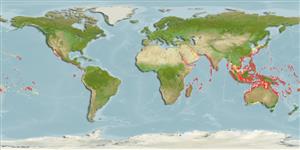Environment: milieu / climate zone / depth range / distribution range
Ekologi
laut; payau berasosiasi dengan karang; nir-ruaya; kisaran kedalaman 1 - 50 m (Ref. 90102). Tropical; 25°C - ?; 36°N - 36°S, 24°E - 77°W
Indo-Pacific : Red Sea and East Africa (Ref. 4919) to Panama, north to southern Japan and the Hawaiian Islands, south to Lord Howe and Rapa islands. Eastern Pacific: Baja California and the Gulf of California to Panama (Ref. 9349, 11482).
Size / Weight / umur
Maturity: Lm ? range ? - ? cm
Max length : 50.0 cm TL jantan/; (Ref. 30874); Berat maksimum terpublikasi: 2.0 kg (Ref. 40637)
Duri punggung (Keseluruhan (total)) : 0; duri punggung lunak (Keseluruhan (total)) : 10 - 11; Duri dubur: 0; Sirip dubur lunak: 10 - 11. This species is characterized by the following: The body is generally greenish-brown in color, the back, sides and caudal fin profusely speckled with white spots, and the belly marked with white bars. A single bent lateral line. Body with small spines except around snout and caudal peduncle. Each nostril with two fleshy solid tentacles. Restricted gill opening.
Inhabit outer reef slopes to depths of at least 50 m, inner reef flats and lagoons. Juveniles common in weedy areas of estuaries (Ref. 4919). Also found in coastal bays and estuaries, usually near rocky reef or on sand-stretches between reefs with low algae-rubble reef to about 20 meters depth, or in shallow with sparse seagrass growth (Ref. 48637). Benthopelagic (Ref. 58302). Usually solitary and territorial on sandy to rubble areas. Feed on fleshy, calcareous, or coralline algae, detritus, mollusks, tunicates, sponges, corals, zoanthid anemones, crabs, tube worms and echinoderms (Ref. 1602).
Life cycle and mating behavior
Kematangan | Reproduksi, perkembang biakan | Pemijahan | telur-telur | Fecundity | Larva
Myers, R.F., 1991. Micronesian reef fishes. Second Ed. Coral Graphics, Barrigada, Guam. 298 p. (Ref. 1602)
Status IUCN Red List (Ref. 130435: Version 2024-1)
ancaman kepada manusia
Poisonous to eat (Ref. 4690)
penggunaan manusia
Perikanan: nilai komersial kecil; Ikan buruan: ya; Akuarium: Komersial
Alat, peralatan
laporan khas
muat turun XML
Sumber internet
Estimates based on models
Preferred temperature (Ref.
123201): 23.7 - 29, mean 27.7 °C (based on 1504 cells).
Phylogenetic diversity index (Ref.
82804): PD
50 = 0.5000 [Uniqueness, from 0.5 = low to 2.0 = high].
Bayesian length-weight: a=0.03981 (0.02445 - 0.06482), b=2.82 (2.69 - 2.95), in cm total length, based on LWR estimates for this species & Genus-body shape (Ref.
93245).
Trophic level (Ref.
69278): 3.2 ±0.0 se; based on diet studies.
Daya lenting (Ref.
120179): sedang, Waktu penggandaan populasi minimum 1.4 - 4.4 tahun (Preliminary K or Fecundity.).
Fishing Vulnerability (Ref.
59153): Moderate vulnerability (40 of 100).
Nutrients (Ref.
124155): Calcium = 33.9 [14.1, 86.4] mg/100g; Iron = 0.555 [0.297, 1.204] mg/100g; Protein = 18.6 [16.4, 20.7] %; Omega3 = 0.113 [0.059, 0.212] g/100g; Selenium = 37.1 [18.8, 80.3] μg/100g; VitaminA = 38.4 [10.4, 141.7] μg/100g; Zinc = 1.13 [0.76, 1.70] mg/100g (wet weight); based on
nutrient studies.
